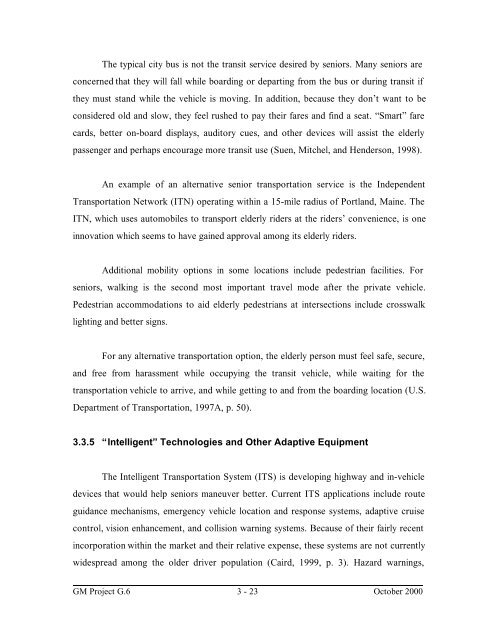Projecting Fatalities in Crashes Involving Older Drivers, 2000-2025
Projecting Fatalities in Crashes Involving Older Drivers, 2000-2025
Projecting Fatalities in Crashes Involving Older Drivers, 2000-2025
You also want an ePaper? Increase the reach of your titles
YUMPU automatically turns print PDFs into web optimized ePapers that Google loves.
The typical city bus is not the transit service desired by seniors. Many seniors are<br />
concerned that they will fall while board<strong>in</strong>g or depart<strong>in</strong>g from the bus or dur<strong>in</strong>g transit if<br />
they must stand while the vehicle is mov<strong>in</strong>g. In addition, because they don’t want to be<br />
considered old and slow, they feel rushed to pay their fares and f<strong>in</strong>d a seat. “Smart” fare<br />
cards, better on-board displays, auditory cues, and other devices will assist the elderly<br />
passenger and perhaps encourage more transit use (Suen, Mitchel, and Henderson, 1998).<br />
An example of an alternative senior transportation service is the Independent<br />
Transportation Network (ITN) operat<strong>in</strong>g with<strong>in</strong> a 15-mile radius of Portland, Ma<strong>in</strong>e. The<br />
ITN, which uses automobiles to transport elderly riders at the riders’ convenience, is one<br />
<strong>in</strong>novation which seems to have ga<strong>in</strong>ed approval among its elderly riders.<br />
Additional mobility options <strong>in</strong> some locations <strong>in</strong>clude pedestrian facilities. For<br />
seniors, walk<strong>in</strong>g is the second most important travel mode after the private vehicle.<br />
Pedestrian accommodations to aid elderly pedestrians at <strong>in</strong>tersections <strong>in</strong>clude crosswalk<br />
light<strong>in</strong>g and better signs.<br />
For any alternative transportation option, the elderly person must feel safe, secure,<br />
and free from harassment while occupy<strong>in</strong>g the transit vehicle, while wait<strong>in</strong>g for the<br />
transportation vehicle to arrive, and while gett<strong>in</strong>g to and from the board<strong>in</strong>g location (U.S.<br />
Department of Transportation, 1997A, p. 50).<br />
3.3.5 “Intelligent” Technologies and Other Adaptive Equipment<br />
The Intelligent Transportation System (ITS) is develop<strong>in</strong>g highway and <strong>in</strong>-vehicle<br />
devices that would help seniors maneuver better. Current ITS applications <strong>in</strong>clude route<br />
guidance mechanisms, emergency vehicle location and response systems, adaptive cruise<br />
control, vision enhancement, and collision warn<strong>in</strong>g systems. Because of their fairly recent<br />
<strong>in</strong>corporation with<strong>in</strong> the market and their relative expense, these systems are not currently<br />
widespread among the older driver population (Caird, 1999, p. 3). Hazard warn<strong>in</strong>gs,<br />
GM Project G.6 3 - 23 October <strong>2000</strong>
















